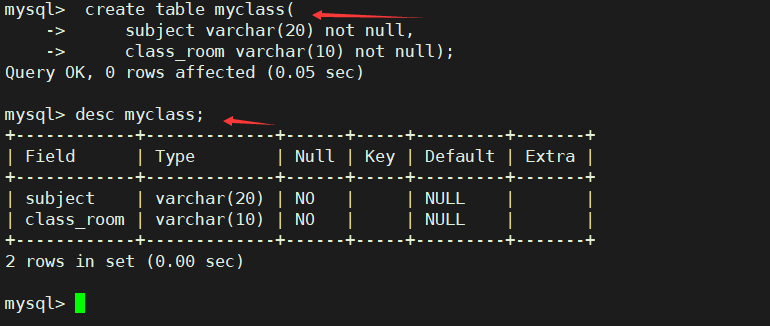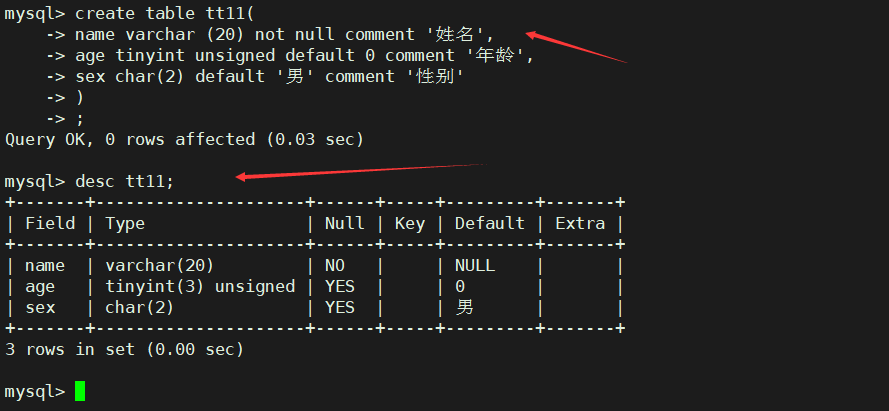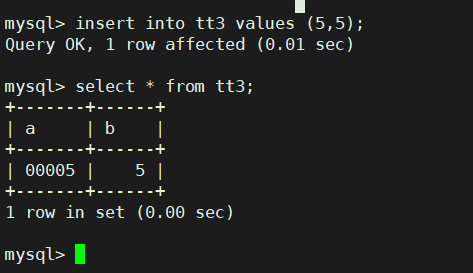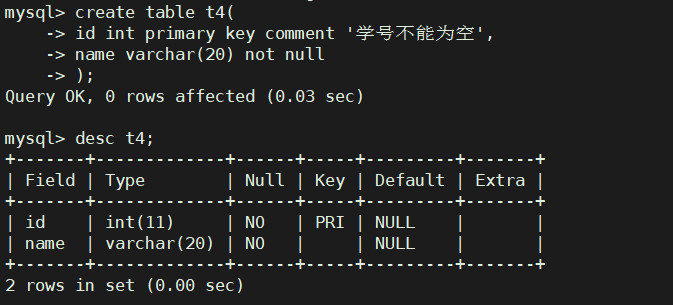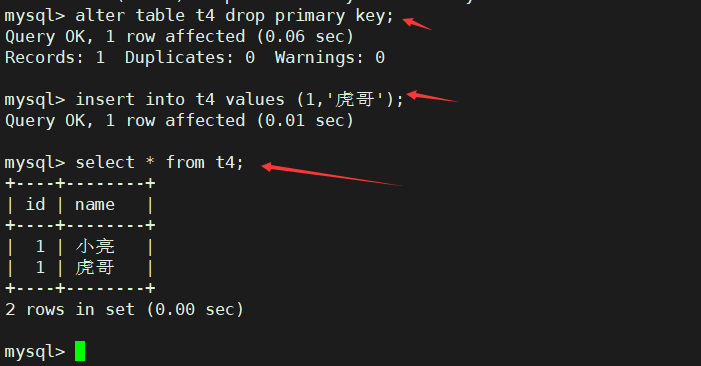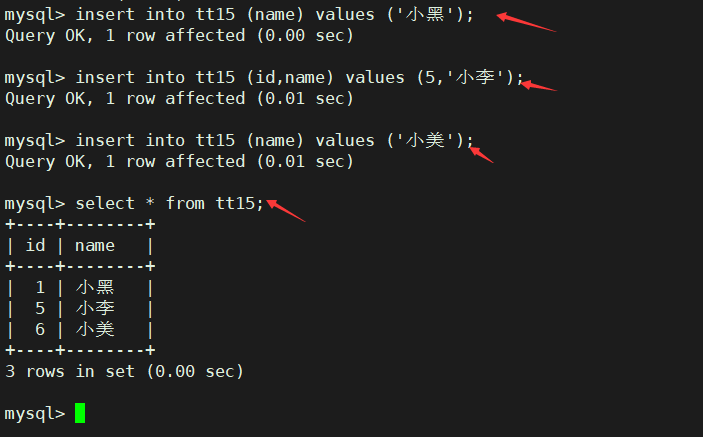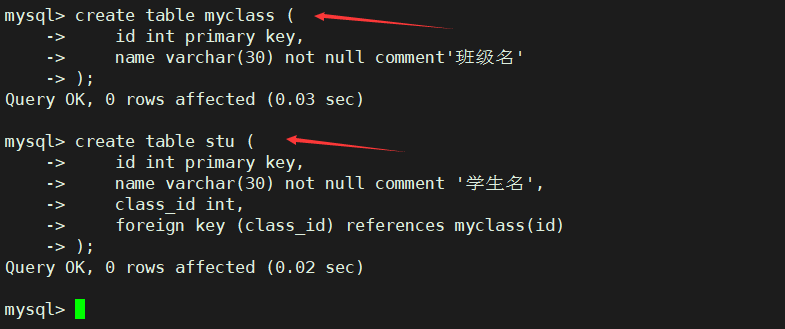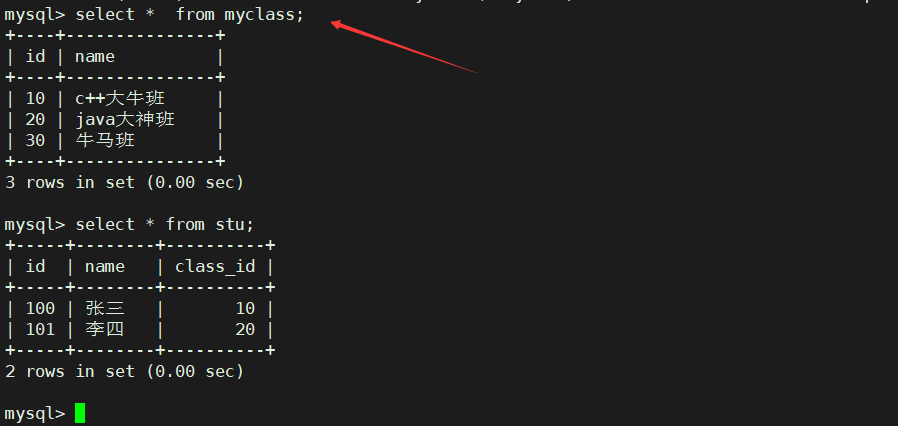【Mysql】 表的约束
文章目录
- 【Mysql】 表的约束
-
-
- 空属性
- 默认值
- 列描述
- zerofill
- 主键
- 自增长
- 唯一键
- 外键
- 综合案例
-
【Mysql】 表的约束
上一个博客记录的是mysql中的类型,这篇博客记录的是mysql中的表的约束;即列字段对插入数据的约束
空属性
- 俩个值:
null(默认) 和not null(不为空) - 描述: 数据库默认字段基本都是空字段, 但是实际开发时,尽可能保证字段不为空,因为数据库为空没办法参与运算,这时候就可以使用not null 描诉该列字段
例:
先创建一个班级表,包含课程名和课程上课的教室位置
站在正常的逻辑中, 身为一个‘大学性’:
- 如果课程没有名字,你就不知道该带什么书去上课
- 如果上课的教室没有,就不知道该去那听课
create table myclass(
subject varchar(20) not null,
class_room varchar(10) not null);
插入数据时,其中一项没有给数据,都会插入失败
注: 使用desc 可以分析表结构
默认值
- 默认值: 某一种数据会经常性的出现某个具体的值,可以在一开始就指定好,在需要真实数据的时候,用户可以选择性的使用默认值。
例:
create table tt10 (
name varchar(20) not null,
age tinyint unsigned default 0,
sex char(2) default '男'
);
对于有默认值的字段,如果插入数据时没有指定时,就以默认初始值插入数据
列描述
- 列描述:comment,没有实际含义,专门用来描述字段,会根据表创建语句保存,用来给程序员或DBA来进行了解 – 可类比于 我们写代码时的注释
例:
create table tt11(
name varchar (20) not null comment '姓名',
age tinyint unsigned default 0 comment '年龄',
sex char(2) default '男' comment '性别'
) ;
值得注意的地方是使用desc是看不到 描诉内容的;
但是使用show 可以
zerofill
刚开始学习数据库时,很多人对数字类型后面的长度很迷茫。 我们可以看到上面tinyint(3) ,这个代表什么意思呢?实际上就是代表age数据表示位数为 3位 即0 ~ 111;
例:
create table tt3(
'a' int (5) unsigned zerofill default null ,
'b' int (10) unsigned
);
插入数据(10,10)
然后再将列字段b的也改为zerofill看看会有什么变化,并且故意将无符号设置去掉,查看插入负数是否具有前导0;
alter table tt3 change b b int (10) zerofill;
试着插入数据 (19,-19);
发现当int 添加zerofill 之后,相当于一起设置了无符号;
- 所以说: zerofill 实际上就是当int (n) 中,的数据不够n位时(10进制),会自动补前导0
主键
-
主键:
primary key用来唯一的约束该字段里面的数据,不能重复,不能为空,一张表中最多只能有一个主键;主键所在的列通常是整数类型。 -
主键特点: 1. 主键对应的字段不能重复
-
创建主键的方式:
- 创建表时直接指定主键
- 创建表后,没有主键的情况下,追加主键
创建表时直接在字段指定主键
create table t4(
id int primary key comment '学号不能为空',
name varchar(20) not null
);
插入的数据主键值重复,操作失败
当表创建好以后但是没有主键的时候,可以再次追加主键
alter table 表名 add primary key (列字段名)
删除主键
alter table 表名 drop primary key;
删除主键之后就可以插入主键值相同的数据了
注: 表有数据时,想要将某个字段设为主键,该字段的数据必须没有冲突
复合主键
在创建表的时候,在所有字段之后,使用primary key(主键字段列表)来创建主键,如果有多个字段作为主键,可以使用复合主键。
mysql> create table tt14(
-> id int unsigned,
-> course char(10) comment '课程代码',
-> score tinyint unsigned default 60 comment '成绩',
-> primary key(id, course) -- id和course为复合主键
-> );
- 注: 复合主键值,只有在俩项都冲突时,才会认为具有冲突
自增长
auto_increment:当对应的字段,不给值,会自动的被系统触发,系统会从当前字段中已经有的最大值+1操作,得到一个新的不同的值。通常和主键搭配使用,作为逻辑主键。- 自增长特点:
- 任何一个字段要做自增长,前提是本身是一个索引(key一栏有值)
- 自增长字段必须是整数
- 一张表最多只能有一个自增长
例:
create table tt15 (
id int unsigned primary key auto_increment,
name varchar(100) not null default ''
);
我们会发现将主键设为自增长之后,相当于id 拥有了默认值
插入数据 ('小黑') (5,’小李’) ('小美')
索引
-
在关系数据库中,索引是一种单独的、物理的对数据库表中一列或多列的值进行排序的一种存储结构,它是某个表中一列或若干列值的集合和相应的指向表中物理标识这些值的数据页的逻辑指针清单。索引的作用相当于图书的目录,可以根据目录中的页码快速找到所需的内容。
-
索引提供指向存储在表的指定列中的数据值的指针,然后根据您指定的排序顺序对这些指针排序。数据库使用索引以找到特定值,然后顺指针找到包含该值的行。这样可以使对应于表的SQL语句执行得更快,可快速访问数据库表中的特定信息。
唯一键
计算机就是人类世界的一种映射,mysql中的表也是如此,而我们人的数据中很多都具有唯一性,身份证号,手机电话,qq号… , 所以只有主键表示数据唯一性肯定是不够的,所以还需要其他表属性来维护人信息的唯一性 – 唯一键
唯一键
- 一张表中有往往有很多字段需要唯一性,数据不能重复,但是一张表中只能有一个主键:唯一键就可以解决表中有多个字段需要唯一性约束的问题。
- 主键和唯一键:
- 主键只能有一个,唯一键可以有很多个,所以唯一键和主键是不冲突的,配合使用来满足许多字段需要唯一性约束需求
- 主键 和 唯一键的数据都是不能重复的,但唯一键数据可以为空 – qq号,身份证等数据都是不能重复的
可以将唯一键简单理解为满足表中列字段唯一性需求的补充;
例:
create table student1 (
id char(10) unique comment '学号',
name varchar (10)
);
唯一键的数据是可以为空的
插入数据:(1,'小黑’) , ('小李子')
说明:
- 当一个表中有多个字段需要唯一性约束时,就可以唯一键
- NULL代表为空,也就是说插入多个 (NULL,’名字‘) 的数据是不算重复的
外键
上面所有字段都是描诉一个表里面的字段属性,而外键是描诉表和表之间的关系
- 外键用于定义主表和从表之间的关系:外键约束主要定义在从表上,主表则必须是有
主键约束或unique约束。当定义外键后,要求外键列数据必须在主表的主键列存在或为null
语法:
forgign key (字段名) refercences 主表(列字段)
案例:
分析:
- 学生表是依赖于班级表的,只有班级分好了名单,学生表中才有分类
- 且学生表中的数据class_Id 一定是在主键表中存在的,不然该学生的数据就是非法数据 , 就好像某学校6年级有3个班,却有个同学说自己是6年级4班,说明该学生就不是本学校的
依旧上面的示意图进行设计:
外键: class_id ,从表中stu依赖于主表myclass
- 主表
create table myclass (
id int primary key,
name varchar(30) not null comment'班级名'
);
- 从表
create table stu (
id int primary key,
name varchar(30) not null comment '学生名',
class_id int,
foreign key (class_id) references myclass(id)
);
查看表结构: desc
- 正常插入数据
insert into myclass values (10, 'c++大牛班'), (20,'java大神班') , (30, '牛马班');
-- 插入学生数据
insert into stu values (100,'张三', 10) , (101,'李四',20);
查看表中数据
- 尝试插入非法数据
因为没有40号这个班级在主表中不存在, 所以插入数据不成功
insert into stu values (102,'小李',40);
![]()
小结:
- 一般而言外键在从表中是可重复的,但是在主表中是需要具有唯一性的,所以外键在主表中一般是作为主键的
- 上例的stu表和myclass 表是具有一定的逻辑关系的,通过class_id联系起来的,而这只是单纯的逻辑约束,还需要有实质性的外键约束,mysql会自动为我们维护这种关系 – 外键值非法的数据不能被插入到从表去
综合案例
有一个商店的数据,记录客户及购物情况,有以下三个表组成:
-
商品goods(商品编号goods_id,商品名goods_name, 单价unitprice, 商品类别category, 供应商provider)
-
客户customer(客户号customer_id,姓名name,住址address,邮箱email,性别sex,身份证card_id)
-
购买purchase(购买订单号order_id,客户号customer_id,商品号goods_id,购买数量nums)
要求
-
每个表的主外键
-
客户的姓名不能为空值
-
邮箱不能重复
-
客户的性别(男,女)
SQL:
-- 商品
create table if not exists goods
(
goods_id int primary key auto_increment comment '商品编号',
goods_name varchar(32) not null comment '商品名称',
unitprice int not null default 0 comment '单价,单位分',
category varchar(12) comment '商品分类',
provider varchar(64) not null comment '供应商名称'
);
-- 客户
create table if not exists customer
(
customer_id int primary key auto_increment comment '客户编号',
name varchar(32) not null comment '客户姓名',
address varchar(256) comment '客户地址',
email varchar(64) unique key comment '电子邮箱',
sex enum('男','女') not null comment '性别',
card_id char(18) unique key comment '身份证'
);
-- 购买
create table if not exists purchase
(
order_id int primary key auto_increment comment '订单号',
customer_id int comment '客户编号',
goods_id int comment '商品编号',
nums int default 0 comment '购买数量',
foreign key (customer_id) references customer(customer_id),
foreign key (goods_id) references goods(goods_id)
);

